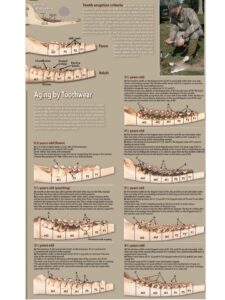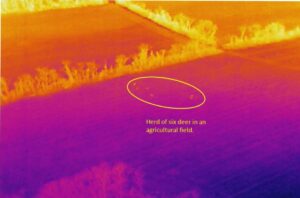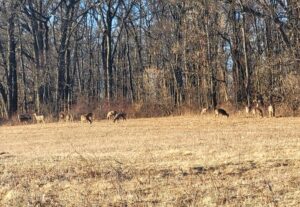Hunting
As stated by the U.S. Fish and Wildlife Service (USFWS): “In the United States, hunting is both a wildlife management tool and an outdoor tradition. By respecting seasons and limits, hunters help ensure healthy wildlife populations are sustainable into the future.”
According to the New Jersey Division of Fish and Wildlife (NJDFW). “White-tailed deer have reached problematic numbers in numerous communities in New Jersey. Increased deer-vehicle collisions, damage to ornamental plantings and gardens, damage to agricultural crops and destruction of the natural forest ecosystem are some of the problems associated with high deer populations.”
A report released in March 2022 out of Rutgers University recorded a loss of $1.3 million caused by white-tailed deer in one year, for just 27 farmers in New Jersey. According to the most recent New Jersey Farm Bureau 2019 NJ Deer Density Survey, deer density measured at 60 to 239 deer per square mile in certain parts of the state. According to USDA-Forest Service, “at densities over 20 per square mile, the effect of deer on native plant species can be devastating. Plant species are eliminated, abundance and size of others are reduced, and overall species composition change.”
According to another recent Rutgers University report, “At appropriate densities, deer help to maintain biodiversity in ecosystems. By feeding on dominant plants within the habitat, deer open up space and resources for less competitive plants, allowing them to gain a foothold in the vegetative community. In this way, moderate browsing balances the ecosystem and increases plant diversity. However, as deer increase in abundance, browsing pressure reaches a tipping point, where individual plants cannot recover from the damage. Plant abundance and diversity decline rapidly, leading to several cascading negative impacts on the ecosystem.
By feeding on or damaging tree seedlings and saplings, an overabundant deer population prevents forests from naturally regenerating. The shrub and herbaceous layers also disappear, leaving a barren woodlot of trees rather than a healthy, functioning forest. With significantly less vegetation than a healthy forest, other ecosystem processes are impacted. The lack of leaves falling to the ground each autumn results in poor quality soils, increased erosion, and a lack of nutrients required for plant growth and reproduction. These changes, combined with the openness of the forest floor, make room for nonnative plant species to colonize, further compromising the health of native habitats.
Habitat changes caused by deer overbrowsing are also detrimental to native birds, small mammals, and invertebrates. Many birds nest in native vegetation on or close to the forest floor, while others rely on the constant supply of insects within the leaf litter and in vegetation to feed themselves and their young. The absence of nuts and berries in overbrowsed forests also leads to a decrease in food supply for birds and mammals, INCLUDING DEER, making it difficult for them to survive at critical times during the year.”
At MCR, white-tailed deer have devastated our forest resources and have altered vegetation structure and species composition. The overabundance of deer and the browse that goes along with it ,combined with other ecological factors, (i.e. disease, invasive insects, exotic vegetation growth and the lack of light reaching the forest floor because of overstocked closed canopy forests), have destroyed critical habitat for many other species that live (or once lived, such as the Ruffed Grouse) at MCR.
MCR conducts annual deer densities surveys and jawbone-teeth aging examinations from harvested deer, as well as, works with USFWS, NJDFW, and science-based conservation organizations in an effort to understand and better balance white-tailed deer densities at the property. MCR also implements a NJ State Approved Forest Stewardship Plan, native planting projects and other conservation practices and prescriptions to restore or enhance habitat at the property. However, regulated hunting is one of the most effective tools that is used to address the overpopulation of a species, as it is an adaptive resource management process when coupled with using sound conservation research methods, principles and practices.
Merrill Creek Conservation & Sportsmen Association (MCCSA)
The Merrill Creek Conservation & Sportsmen Association (MCCSA) was established in 1980 as the organization (Association) through which the Merrill Creek Owners Group (MCOG) provides limited access to its properties (MCR) for hunting. MCCSA is a separate entity from MCR and the MCOG. The MCCSA holds its own insurance and operates under its own By-laws and Operating Rules. Also, with a strong interest among its members in conservation and wildlife, the Association takes part in various wildlife management projects.
For all information pertaining to MCCSA please contact one of the Officers. Do not contact MCR! Thank you.
List of MCCSA Officers:
- President: Dave Nattress—908-319-4904
- Vice President: Jeff Armbruster–908-246-5069
- Officer at Large: Rich Corona–908-859-2878
- Treasurer: Dave Kubich— 917-337-8307
- Administrator: Sharon Kubich—908-343-9031
Membership Information & Printable Waiting List Application
Honorary Membership Information & Printable Honorary Membership Form
Guest Pass Information & Regulations & Printable Guest Pass Application
MCCSA Schedule of Meetings/Events
The annual deadline for membership renewals is May 31. Dues are $70. Please complete the membership form and mail with payment to the address at the bottom.
Submit dues to:MCCSA MEMBERSHIP CHANGE FORM
Mr. David Kubich
205 Park Ave.
Phillipsburg, NJ 08865




